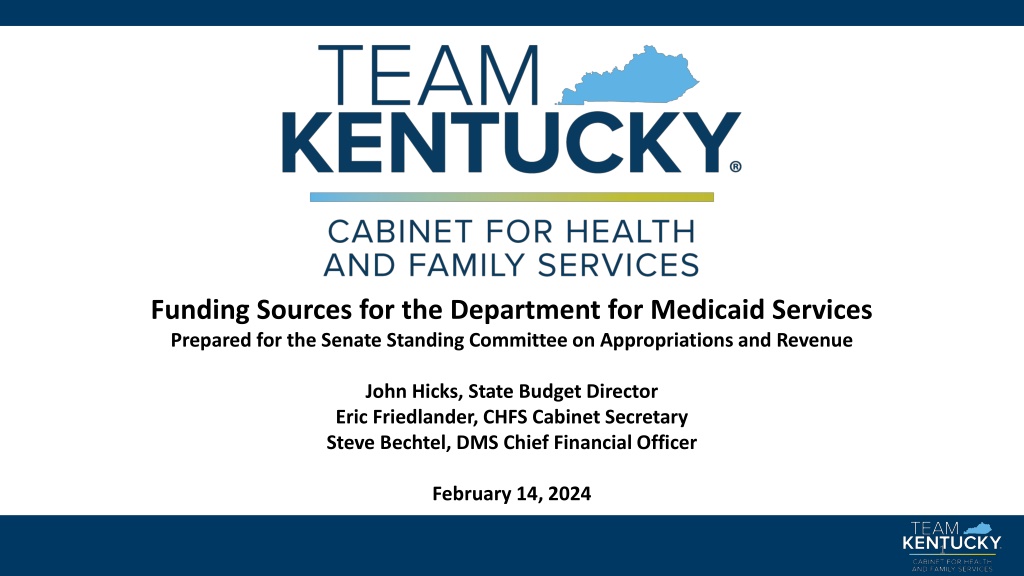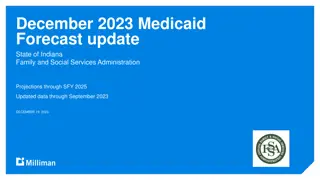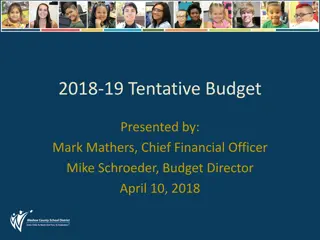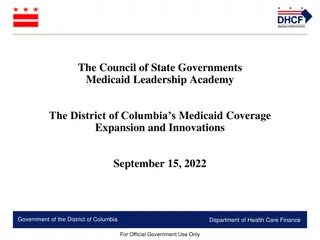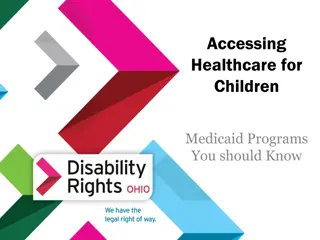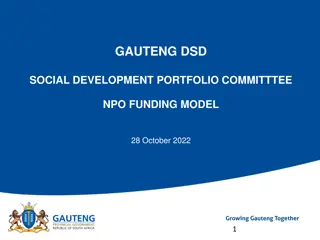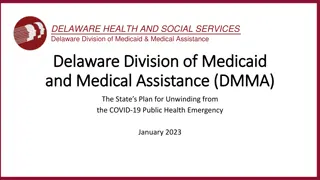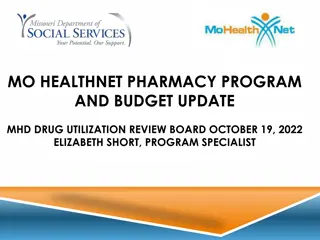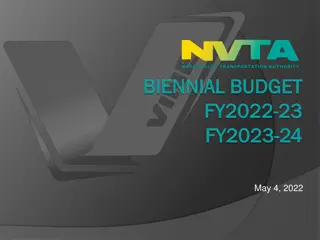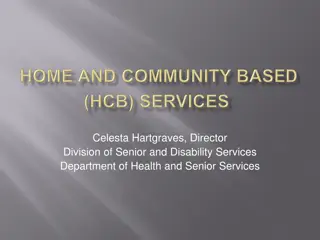Funding Sources for Medicaid Department Budget
This document outlines the sources of funding for the Department for Medicaid Services budget, including state funds, federal funds, and the Medicaid benefits budget forecasting process. It details the components of the Medicaid budget, funding sources, and the forecasting methods used to estimate benefit expenditures.
Download Presentation

Please find below an Image/Link to download the presentation.
The content on the website is provided AS IS for your information and personal use only. It may not be sold, licensed, or shared on other websites without obtaining consent from the author.If you encounter any issues during the download, it is possible that the publisher has removed the file from their server.
You are allowed to download the files provided on this website for personal or commercial use, subject to the condition that they are used lawfully. All files are the property of their respective owners.
The content on the website is provided AS IS for your information and personal use only. It may not be sold, licensed, or shared on other websites without obtaining consent from the author.
E N D
Presentation Transcript
Funding Sources for the Department for Medicaid Services Prepared for the Senate Standing Committee on Appropriations and Revenue John Hicks, State Budget Director Eric Friedlander, CHFS Cabinet Secretary Steve Bechtel, DMS Chief Financial Officer February 14, 2024 1
Department for Medicaid Services Budget The benefits budget for the Department for Medicaid Services (DMS) consists of: Fee for Service (FFS) payments Managed Care Capitation Payments Managed Care Organizations (MCO) Non-Emergency Medical Transportation (NEMT) Below the Line items Medicare Part A and Part B premiums Part D Medicare Clawback Drug Rebates Any potential additional funding for additional projects that occur outside of the baseline submitted via Additional Budget Requests (ABRs) 2
Medicaid Sources of Funding Medicaid is a joint federal-state program and is funded with: State Funds (historically 20-23%): General Fund Appropriations provided by the general assembly Restricted Fund Appropriations supported with agency cash Federal Funds (historically 77-80%): The state funds are matched by federal funds Blended Federal Match Blended State Match FY 2024 FY 2025 FY 2026 FY 2024 FY 2025 FY 2026 Traditional Medicaid* 72.88% 71.57% 71.50% 27.12% 28.43% 28.50% CHIP 81.01% 80.10% 80.05% 18.99% 19.90% 19.95% Expansion 90.00% 90.00% 90.00% 10.00% 10.00% 10.00% *Enhanced FMAP during the Public Health Emergency phased out by December 31, 2023. During FY 2023, the traditional FMAP was 78.95% 3
Benefits Budget Forecasting Process The projected benefit expenditures are developed via a consensus forecasting group: Department budget staff (DMS Chief Finance Officer and Fiscal Management Staff) Cabinet for Health and Family Services Budget Staff (CHFS Budget Director and Office of Finance and Budget) Office of State Budget Director (Economist, Analysts, Deputy State Budget Director) By using historical data and various forecasting models, this group collectively projects and estimates Medicaid MCO enrollment (by MCO rate cell) and FFS expenditures (by category of service). The following time-series methods are utilized in the process: Univariate time series models are created utilizing numerous statistical methods to analyze each data series o ARIMA models o Trend and Seasonal Decomposition models Multivariate time series models are created utilizing numerous statistical methods to analyze each data series and the relationship of the series to exogenous variables (i.e. economic variables, policy changes, etc.) chosen based on empirical evidence or by economic theory o Vector Autoregression models o Vector Autoregression Moving-Average with Exogenous Regressors (VARMAX) o Structural Models with Autoregressive Error Correction The enrollment projections are placed into a cash model to estimate the MCO spend. The final product from this exercise is the Consensus Forecast that makes up the Medicaid Benefits budget projections. 4
Benefits Budget For consensus forecasting, current and recent state fiscal year expenditures are considered including largest cost drivers of the budget: FY 2021 5,460,108,200 $ 1,725,098,800 $ 2,007,774,500 $ 409,560,300 $ 995,816,500 $ 1,087,279,100 $ 11,685,637,400 $ 14,384,965,900 $ 81.24% FY 2022 6,314,016,600 $ 1,855,148,900 $ 2,506,964,400 $ 503,373,900 $ 1,086,870,500 $ 1,233,348,100 $ 13,499,722,400 $ 14,892,270,700 $ 90.65% FY 2023 6,700,602,300 $ 2,014,179,400 $ 3,027,476,400 $ 566,945,200 $ 1,454,933,500 $ 1,316,085,400 $ 15,080,222,200 $ 16,575,106,500 $ 90.98% Hospital Physician Pharmacy FQHC/RHC 1915C Waivers Nursing Facilities Total Total Expenditures % of budget 5
Benefits Budget For consensus forecasting, enrollment trends are projected based on a variety of factors, including the restart of redeterminations following the end of the public health emergency. The Governor s recommended budget assumed the following eligibility forecast: Managed Care (MCO) Fee For Service (FFS) Grand Total FY 2024 1,441,453 142,864 1,584,317 FY 2025 1,398,450 145,026 1,543,476 FY 2026 1,438,392 148,083 1,586,475 6
Medicaid Sources of Funding Medicaid s agency cash accounts are funded through various provider taxes and intergovernmental transfers (IGTs): Source of Funds FY 2024 $695,825,700 FY 2025 $487,275,400 FY 2026 $116,236,000 Beginning cash balance: Provider Taxes $318,098,100 $323,660,100 $337,591,200 Hospital Rate Improvement Program (HRIP) Assessment $567,000,000 $567,000,000 $567,000,000 University Directed Payments 1% Assessment (KY Access funds and managed care) Other IGTs with state agencies and public universities $267,652,300 $138,971,500 $68,770,800 $267,652,300 $135,033,500 $164,611,600 $1,457,957,500 $267,652,300 $138,231,000 $164,542,800 $1,475,017,300 Projected receipts: $1,360,492,700 Total projected available cash: $2,056,318,400 Total Projected Restricted Fund Expenditures:($1,569,043,000) ($1,828,996,900) ($1,591,253,300) Ending Balance: $487,275,400 $1,945,232,900 $1,591,253,300 $116,236,000 $0 7
Funding Concerns in House Bill 6 Medicaid Current Services Medicaid Current Services FY 2025 State Funds Federal Funds Total Medicaid Base Reductions (General Funds) $71,915,000 $211,472,700 $283,387,700 Medicaid Base Reductions (Restricted Funds) $43,833,400 $128,896,200 $172,729,600 Total Medicaid Base Reductions: $115,748,400 $340,368,900 $456,117,300 *The Governor s Recommended budget in FY 2025 included $61.7M Restricted Funds and $541M federal funds that were available but omitted in House Bill 6. 8
Funding Concerns in House Bill 6 Continued Initiative FY 2025 FY 2026 Nursing Facility Reimbursement (Funds switched from General to Restricted) $43,833,400 - Nursing Facility Reimbursement (Reduction of General Fund) $4,500,000 - Serious Mental Illness Waiver (Funds switched from General to Restricted) $4,307,100 $4,626,300 Mobile Crisis (Funding was removed from HB6) $2,745,200 $2,819,300 Total Medicaid Benefits $55,385,700 $7,445,600 9
Benefits Budget FY 2025 Difference between HB114 and HB6 General Funds (71,915,000) $ (2,745,200) $ (48,333,400) $ (4,307,100) $ $ (127,300,700) $ Restricted Funds Total State Funds (43,833,400) $ - $ 43,833,400 $ 4,307,100 $ (61,703,400) $ (57,396,300) $ Baseline (115,748,400) $ (2,745,200) $ (4,500,000) $ $ (61,703,400) $ (184,697,000) $ Mobile Crisis Rebasing of Nursing Facility Rates Serious Mental Illness Waiver Continued services - - Total In summary, our concerns with HB6 are: reduces baseline by $115.7M in state fund appropriations in FY 2025 eliminates all funding for Mobile Crisis in both FY 2025 and FY 2026 reduces state funding for rebasing of nursing facility rates by $4.5M and replaces $43.8M of general funds with restricted fund appropriations in FY 2025 replaces $4.3M of general funds for Serious Mental Illness Waiver with restricted fund appropriations in FY 2025 reduces continued services by $61.7M in state fund appropriations 10
Department Concerns HB6 does not fully fund the Medicaid program based on current funding and projected enrollment. HB6 does not appropriately and fully fund rebasing for nursing facilities putting services to long-term care members at risk. Important to consider - any legislation that adds services, expands services, or increases provider reimbursements, must be accompanied by a General Fund appropriations to be implemented. 11 11
QUESTIONS and/or Comments? 12
